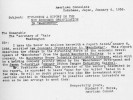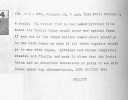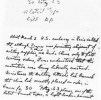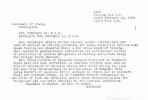What were the Pumpkin Papers?
The Pumpkin Papers consist of sixty-five pages of retyped secret State Department documents, four pages in Hiss's own handwriting of copied State Department cables, and five rolls of developed and undeveloped 35 mm film. The film included fifty-eight frames, mostly photos of State and Navy Department documents. The State Department documents dealt with a wide variety of subjects, including U. S. intentions with respect to the Soviet Union, the Spanish Civil War, and Germany's takeover of Austria. Other frames dealt with subjects that hardly seem the stuff of spy novels, such as diagrams of fire extinguishers and life rafts. All of the documents that bore dates came from the period from January 5 through April 1, 1938.
Four images of Pumpkin Papers are included below. To see a larger image, click on the thumbnail photo. 



Why the name "Pumpkin Papers"?
More accurately, the Pumpkin Papers would be called the "Dumbwaiter Papers." The sixty-five typed pages and four handwritten pages all came from an envelope removed from a dumbwaiter shaft in the Baltimore home of Whittaker Chambers's nephew's mother, where they apparently had been kept for ten years. (The typed papers and notes are sometimes called "the Baltimore papers.") The name "Pumpkin Papers" comes from the fact that the rolls of 35 mm film were found wrapped in waxed paper inside a hollowed-out pumpkin on Whittaker Chambers's Maryland farm. In response to a HUAC subpoena, Chambers on the evening of December 2, 1948 dramatically led two HUAC investigators to the patch, where the film had been placed by Chambers only the previous day. 
The hollowed-out pumpkin at Chambers's farm that contained two rolls of undeveloped film.
Chambers led HUAC investigators to the pumpkin on December 2, 1948.
Who typed the papers?
The identity of the typist of the sixty-five State Department documents was a major point of contention. The government argued, and successfully convinced the second Hiss jury, that the documents were typed on Woodstock typewriter, number N230099, owned by the Hiss's in early 1938. The 1938 papers, according to experts who did comparisons, were typed on the same machine as produced other Hiss typing from the earlier 1930s.
The government maintained that Hiss's wife, Priscilla, typed the documents (Alger was a hunt-and-peck typist) because he could not risk keeping the originals more than overnight, and that Chambers collected material for the Soviets only every seven to ten days. Simply put, the government asked jurors in the Hiss trial who--other than Alger or Priscilla Hiss--had access both to the State Department documents and the Woodstock typewriter, and therefore could be a possible source of the Pumpkin Papers?
Hiss argued at trial that neither he nor his wife could have typed the documents because the Woodstock typewriter identified as having been used to type the documents was given away by them in 1937. The defense made much of the fact that no documents known to have come from Hiss's Woodstock typewriter (originally purchased by Priscilla Hiss's father in 1927) could be found bearing a date of later than May 1937. Hiss testified that he gave the typewriter in 1937 to Mike Catlett, a man who did odd jobs around the Hiss household. Catlett confirmed that he received the Woodstock typewriter from Hiss, but could not remember the date he took possession of the machine. Mike's son, Pat Catlett, on the other hand, told defense lawyers that the family received the typewriter in the spring of 1938, a date more helpful to the prosecution than the defense.

Woodstock N230099
When was the film found in the pumpkin manufactured?
HUAC sent the film to Eastman Kodak to determine the date of manufacture. Initial test results indicated that the film was manufactured in 1945. If these results were accurate, Chambers lied and Hiss was vindicated. Based on the initial results, an outraged Richard Nixon even called Chambers and told him he was a liar. Subsequently, however, Eastman Kodak reported the initial report was wrong, and that the film was made in 1938, consistent with Chambers's story.
Why did Whittaker Chambers reveal the existence of the papers when he did?
Whittaker Chambers made no mention during the HUAC hearings in August 1948 of the papers he said were given to him by Hiss. He explained later that he did not reveal the existence of the papers in order to protect Hiss, who he called "a good friend," from espionage charges. Things changed, however, when Hiss sued Chambers for slander. While conducting a pretrial deposition of Chambers, Hiss's attorney, William Marbury, asked Chambers to produce "any correspondence, either typewritten or in handwriting, from any member of the Hiss family." Hiss's attorney never expected (nor would he have asked for, had he known) the response that he received: sixty-five typewritten pages and four handwritten pages, all allegedly given to Chambers by Hiss in 1938. Chambers turned over the documents on November 17, 1948. Chambers made a statement at the time:
In response to your request to produce papers from Mr. Hiss, I made a search, and I have certain papers in Mr. Hiss's handwriting and certain other papers...I was particularly anxious, for reasons of friendship, and because Mr. Hiss is one of the most brilliant young men in the country, not to do more injury than necessary to Mr. Hiss. Therefore, I have carefully avoided testifying to certain activities of Mr. Hiss an any place or any time heretofore...
Chambers later told Nixon and HUAC staffers that he turned over the documents because of Hiss's attorney's investigation into his alleged mental instability and aggressive questioning of his wife. Chambers said that he concluded that "Hiss was determined to destroy me--and my wife, if possible." Another factor might have been Chambers's concern that if a jury found him guilty of slandering Hiss, Chambers in all likelihood would have faced a Justice Department prosecution himself.
Where were the papers between 1938 and 1948?
There is evidence suggesting that Chambers originally gave the documents for safekeeping to a Communist friend named Ludwig Lore. After a year or so, Chambers apparently asked Lore to give him back the documents. From approximately 1939 to their removal in November, 1948, the envelope containing the documents and film was stored in a dumbwaiter shaft in a Baltimore house. The house was formerly occupied by Nathan Levine, Whittaker Chambers's nephew. At the time of the removal of the documents, the home belonged to Nathan Levine's mother. 
Weathered envelope, found in a dumbwaiter shaft in Baltimore,
in which the documents were found.
Why did Whittaker Chambers save the documents?
The papers date to the time of Chambers's decision to leave the Communist Party. At the time of his defection in 1938, Chambers feared for his life. Chambers believed that hiding evidence that might incriminate another important Soviet agent might be a measure of protection against those who would wish to do him harm.
What role did the Pumpkin Papers play in the conviction of Alger Hiss?
The Pumpkin Papers played a decisive role in the Hiss trials. The government produced witnesses who traced the contents of various of the papers to the office of Francis Sayre at the Department of State--Hiss's office in 1938. Another witness explained the relative secrecy of the retyped messages and how they must have been based on stolen documents. Still other experts identified the typing as being done on Hiss's Woodstock. The most critical testimony came from FBI laboratory expert Ramos Feehan who, by comparing characters (for example individual "e"s and "g"s) on "Hiss standards" (letters concededly typed by Hiss in the 1930s) and the 65 typed papers recovered in Baltimore, concluded that they were produced by the same machine.
Jurors in the deadlocked first Hiss trial agreed that the Pumpkin Papers were the key evidence. Eight jurors accepted the prosecution's argument that Priscilla Hiss typed the papers on their Woodstock typewriter. The four holdouts for acquittal accepted that the papers were typed on the Woodstock formerly owned by the Hiss's, but thought that perhaps someone other than either Hiss composed them.
In the second trial, prosecutor Thomas Murphy closed by telling the jurors, "Each of these documents, the typewritten documents, and the handwritten documents, each has the same message. And what is that message?: "Alger Hiss, you were the traitor. Alger Hiss, your feathers are but borrowed and you can't change these documents." This time, all twelve jurors bought Murphy's argument and convicted Hiss of perjury.
Did Alger Hiss ever admit that the papers were genuine?
No. Alger Hiss continued to contend, even after his appeal was rejected, that the sixty-five pages were forged by Chambers--either using Hiss's borrowed typewriter or forging them "so as to make them appear to have been written on the Hiss typewriter." He conceded, however, that the four notes were in his handwriting.
